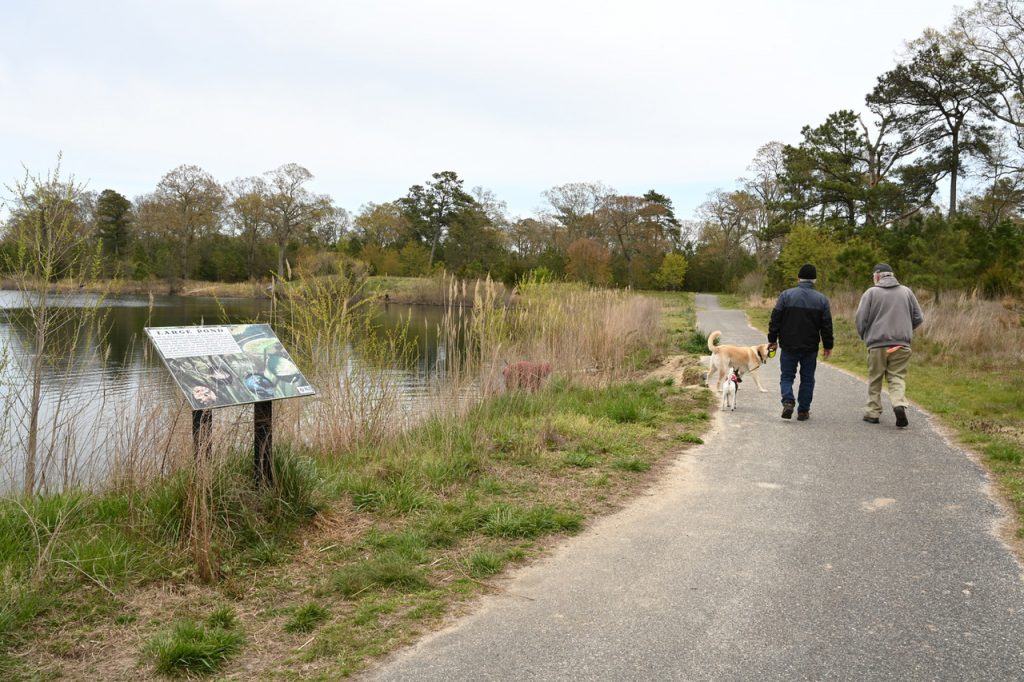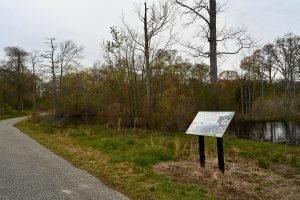Funnel of Fun
Cox Hall Creek Wildlife Management Area, just four miles from the tip of the Cape May Peninsula, is where birds funnel before crossing the Bay on their southern migrations.

If you have been reading our column you know we’ve been travelling the Bayshore Heritage Byway and checking out places to visit along the route as we prepare our All-American Road application form.
This weekend I returned to a location that CU Maurice River often visits on our Tuesdays on the Fly during tick or chigger season: Cox Hall Creek Wildlife Management Area (WMA). Huh? Well, nearly as much as putting their sippy straws into you, ticks and chiggers like vegetation. So if we stay on lonely roads, cleared trails, or better yet paved paths when their numbers are high, we have less exposure. That’s tip #1.
 The Cox Hall Creek Wildlife Management Area is near the Villas; it is a fishing spot but not a hunting area, at least not near the heavily travelled paths. What makes it special is its location on the Cape May Peninsula, which has gained international recognition for its spectacular concentrations of birds during the spring and fall migrations. Many birding authorities consider the Peninsula as one of the most important migratory bird stopover habitats in the country. Because of its unique configuration and geographic location along the Atlantic Flyway, millions of songbirds, raptors, and shorebirds are funneled into the lower 10 kilometers of the Cape May peninsula every year.
The Cox Hall Creek Wildlife Management Area is near the Villas; it is a fishing spot but not a hunting area, at least not near the heavily travelled paths. What makes it special is its location on the Cape May Peninsula, which has gained international recognition for its spectacular concentrations of birds during the spring and fall migrations. Many birding authorities consider the Peninsula as one of the most important migratory bird stopover habitats in the country. Because of its unique configuration and geographic location along the Atlantic Flyway, millions of songbirds, raptors, and shorebirds are funneled into the lower 10 kilometers of the Cape May peninsula every year.
This area also serves an essential role during the migration of many bat, butterfly, and dragonfly species. Cox Hall is only four miles from the tip of the peninsula and nearly surrounded by neighborhoods, making it an oasis for wildlife visitation and travelers alike—what I call a wildlife sink. Know that lots of southern New Jersey is really part of the Peninsula from a geographic perspective, or the “big view.” The more the land narrows toward the tip of the state, the more concentrated birds become as they seek to cross over the Delaware Bay during migration.
When neotropical birds make the crossing going north in the spring, they may rest in the Peninsula before moving on. Some of the neotropical birds nest here but others choose areas farther north. On southbound trips birds wait for favorable wind and weather conditions before crossing the Bay. Some birds will double back to the north and cross at narrower spots like East Point.
Water crossings for birds can present perils but proper conditions can make passage easier. An example of this would be when raptors save energy by riding thermals on warmer days; once they have gained proper altitude they can simply glide across the Delaware Bay. These strategies have earned Cape May Point the nickname “Raptor Capitol of the World.”
It is this geographic positioning that makes Cox Hall Creek special. One unusual attribute is that it’s the site of a former golf course. The 253-acre Ponderlodge Golf Course was purchased in 2006 by the NJ Green Acres Program, and today the site is part of the 463-acre Cox Creek WMA. When purchased it was one of the last and largest undeveloped pieces remaining in the lower Cape May Peninsula. Its flat terrain with about four miles of asphalted trail loops is perfect for wheelchair and bicycle access. That’s tip #2.
The golf course entities are no longer present and the site has undergone at least 10 years of restoration. In 2012 alone more than 2,700 native species were planted. The area is considered a “Backyard Habitat Demonstration Site” for encouraging native vs. exotic species. The non-profit Conserve Wildlife partnered with NJ’s Threatened and Endangered Species Program to design the area for visitors to learn about projects they can install in their own backyards. There are six wildlife management features—forest, scrub-shrub, wildflower meadows, ponds, nectar plants, and brush piles. Interpretative signs help the visitor to gain a greater understanding of these techniques. Wetland woods provide further habitat options for wildlife viewing, with numerous ponds to a total of 9.6 acres of water. Flynn’s Pond is about eight acres and is stocked with trout in the spring. While I was there the fisherman lined the banks and assured me they were having great success, ensuring repeat visits. Tip #3 if you’re counting.
Clearly, the osprey have also returned for the same reason—fishing access. A number of osprey were taking advantage of the stocked areas while we were there. There are also several vernal ponds, the ideal habitat for reptiles and amphibians.
NJ Audubon rates the area as “Above Par” birding with a site that boasts woodpeckers, pine warblers, grosbeaks, sparrows, waterfowl, raptors, and short-eared owls, and it is especially good for spring and fall migrants. It can be a good birding spot in the early morning, Tip #4.
Under normal, non-pandemic conditions I would advise a visit during the week. Since the tract is surrounded by neighborhoods it can be rather well utilized on weekends. Also, not everyone is an early morning birder, so if you bird go early.
If you visit, remember proper COVID etiquette, masks, and distances. Many of the paths are fairly quiet. The area near Flynn’s Pond is busy, so unless you’re fishing there’s no need to hang out there. Okay, there were a few more tips than I highlighted; also, be sure to pay attention to current health guidelines so you can keep exploring southern New Jersey when this madness ends.
To learn more about the Bayshore Heritage Byway, visit NJ’s Department of Transportation’s Scenic Byways website at state.nj.us/transportation/community/scenic/bayshore.shtm. To see our amateur video shorts see the CU Facebook page.









